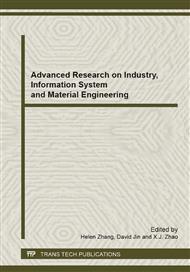p.165
p.169
p.175
p.180
p.184
p.188
p.192
p.196
p.200
Research on the Transference of Cd with Properties of Environmental Materials and Activated Reagent in Underground
Abstract:
The natural transfusion and activated reagent (environmental material) enhanced migration efficiency was studied by the experiments in Cd contaminated groundwater in this work. The experimental results showed that the variation rule of Cd reflected that its migration was weak and the removal efficiency was only 11.36% near the anode zone in the natural seepage condition, but under the enhanced migration function, the pollutants could be enriched and removed faster. The main migrating direction of pollutant was mainly from upstream anode zone to downstream cathode zone, which indicated that the washing function could enhance the migrating efficiency of pollutants. And the Cd of in anode zone decreased relatively quickly and its removal rate was 25.75 %, which made known that this enhanced migration of Cd in contaminated groundwater was more effective method than that of natural seepage migration.
Info:
Periodical:
Pages:
184-187
Citation:
Online since:
March 2013
Authors:
Keywords:
Price:
Сopyright:
© 2013 Trans Tech Publications Ltd. All Rights Reserved
Share:
Citation:


